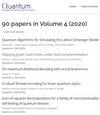Exact results on finite size corrections for surface codes tailored to biased noise
IF 5.1
2区 物理与天体物理
Q1 PHYSICS, MULTIDISCIPLINARY
引用次数: 0
Abstract
The code-capacity threshold of a scalable quantum error correcting stabilizer code can be expressed as a thermodynamic phase transition of a corresponding random-bond Ising model. Here we study the XY and XZZX surface codes under phase-biased noise, $p_x=p_y=p_z/(2\eta)$, with $\eta\geq 1/2$, and total error rate $p=p_x+p_y+p_z$. By appropriately formulating the boundary conditions, in the rotated code geometry, we find exact solutions at a special disordered point, $p=\frac{1+\eta^{-1}}{2+\eta^{-1}}\gtrsim 0.5$, for arbitrary odd code distance $d$, where the codes reduce to one-dimensional Ising models. The total logical failure rate is given by $P_{f}=\frac{3}{4}-\frac{1}{4}e^{-2d_Z\,\text{artanh}(1/2\eta)}$, where $d_{Z}=d^2$ and $d$ for the two codes respectively, is the effective code distance for pure phase-flip noise. As a consequence, for code distances $d\ll \eta$, and error rates near the threshold, the XZZX code is effectively equivalent to the phase-flip correcting repetition code over $d$ qubits. The large finite size corrections for $d_Z \lt \eta$ also make threshold extractions, from numerical calculations at moderate code distances, unreliable. We show that calculating thresholds based not only on the total logical failure rate, but also independently on the phase- and bit-flip logical failure rates, gives a more confident estimate. Using this method for the XZZX code with a tensor-network based decoder and code distances up to $d\approx 100$, we find that the thresholds converge to a single value at moderate bias ($\eta=30, 100$), at an error rate above the hashing bound.针对偏置噪声的表面代码有限尺寸修正的精确结果
可扩展量子纠错稳定器编码的码容量阈值可以用相应的随机键伊辛模型的热力学相变来表示。在此,我们研究了相位偏置噪声下的 XY 和 XZZX 表面编码,即 $p_x=p_y=p_z/(2\eta)$,$\eta\geq 1/2$,总误码率 $p=p_x+p_y+p_z$。通过适当地制定边界条件,在旋转编码几何中,我们找到了特殊无序点的精确解,即对于任意奇数编码距离 $d$,p=\frac{1+\eta^{-1}}{2+\eta^{-1}}\gtrsim 0.5$,此时编码简化为一维伊辛模型。总逻辑失效率为 $P_{f}=\frac{3}{4}-\frac{1}{4}e^{-2d_Z\,\text{artanh}(1/2/eta)}$,其中,两种编码分别为 $d_{Z}=d^2$ 和 $d$,是纯相位翻转噪声的有效编码距离。因此,对于码距为 $d\ll \eta$ 和误码率接近阈值的情况,XZZX 码实际上等同于超过 $d$ qubits 的相位翻转校正重复码。$d_Z \lt \eta$ 的巨大有限尺寸修正也使得在中等代码距离下通过数值计算提取阈值变得不可靠。我们证明,不仅基于总逻辑故障率,而且独立于相位和比特翻转逻辑故障率来计算阈值,可以得到更可靠的估计。使用这种方法对 XZZX 码进行基于张量网络的解码器解码,码距可达 $d\approx 100$,我们发现阈值在中等偏差($\ea=30, 100$)下收敛到单一值,错误率高于散列边界。
本文章由计算机程序翻译,如有差异,请以英文原文为准。
求助全文
约1分钟内获得全文
求助全文
来源期刊

Quantum
Physics and Astronomy-Physics and Astronomy (miscellaneous)
CiteScore
9.20
自引率
10.90%
发文量
241
审稿时长
16 weeks
期刊介绍:
Quantum is an open-access peer-reviewed journal for quantum science and related fields. Quantum is non-profit and community-run: an effort by researchers and for researchers to make science more open and publishing more transparent and efficient.
 求助内容:
求助内容: 应助结果提醒方式:
应助结果提醒方式:


